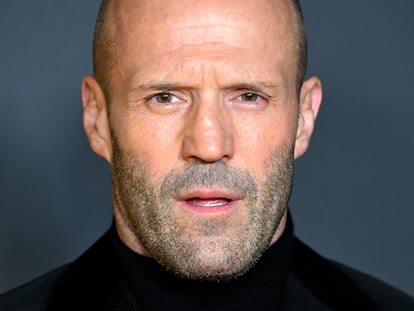Acrobatics, accidents and legal loopholes: The uncertain world of stunt performers
Despite risking their lives at work, there is no legislative framework to protect these professionals

Leaping into the void from great heights, crashing through glass, driving vehicles at breakneck speed, or rolling down burning stairs. Thrilling scenes that seem straight out of a video game, but brought to life on the big screen thanks to a select group of professionals: stunt performers (or stunt doubles). These are workers born for the adrenaline rush, capable of executing extreme maneuvers with surgical precision. Thanks to their performances, action movies never go out of style. A clear example is Mission: Impossible — The Final Reckoning, which grossed $190 million worldwide on its opening weekend. Part of the success of these films is down to those who put their bodies on the line to shoot impossible scenes.
But behind every jump, explosion, or fight lies a less glamorous truth: fractures from miscalculated falls, burns, and in some cases, even death. In 2002, Harry O’Connor, Vin Diesel’s stunt double in xXx, died after crashing into a bridge while skydiving. David Holmes, Daniel Radcliffe’s stuntman in the Harry Potter saga, was left wheelchair-bound after an accident on the set of Harry Potter and the Deathly Hallows (2010) that caused irreversible spinal cord injuries. In 2014, Olivia Jackson, a stuntwoman in Resident Evil: The Final Chapter, suffered injuries so severe that she had to have her arm amputated. A little later, in 2017, the industry was also shocked by the death of stuntwoman SJ Harris during the filming of Deadpool 2.
The profession of these stunt performers is as dangerous as it is necessary. “Nowadays, there is hardly a single film or television series where stunt performers aren’t essential,” says Ángel Plana, an expert with more than 30 years of experience filming risky scenes and the owner of his own stunt school. Plana asserts that, today, stunt performers do much more than just film challenging scenes. They also replace the main actors in seemingly simple sequences, such as driving a car, or riding a motorcycle or even a bicycle. The reason? “Companies can’t allow actors to have a minor accident that paralyzes production.”
Stunt performers aren’t made of iron, and they also require minimum safety conditions. Their work involves extreme risk, but there are no specific regulations protecting them. “The regulatory framework is the same as that of any worker: Workers’ Statute, labor laws, and collective bargaining agreements,” explains Iban Díez, partner at Spanish entertainment industry law firm Menta Legal. However, unlike other professions, being a stunt double entails such a high level of risk that it forces production companies to take extreme preventive measures. “A prior report is usually required for each scene to be filmed, detailing all existing risks and the measures taken to mitigate or eliminate them,” says Díez. This report is essential to cover damages in the event of an incident.
To participate in a production, stunt doubles “must be registered with Social Security and have the necessary training prior to performing any risky scenes,” say Singular Law attorneys Sara Gutiérrez and Isabella Penélope. The contracts also include clauses that oblige the production company to guarantee safety conditions and to have personnel such as stunt coordinators and protective teams.
Lights, camera… protection
Nor is there a specific regulation stipulating the specific safety measures that production companies must follow to ensure the protection of stunt doubles. For this reason, Ángel Plana drafted his own Manual for the Prevention of Occupational Hazards in the Film Stunt and Stunt Work Profession for the Audiovisual Sector, a document used by production companies to establish appropriate safety measures for each scene based on the risk level. These include the obligation to have protective equipment on set, an ambulance on stand-by in case of an accident, and the presence of firefighters for scenes involving fire. Furthermore, according to the manual, stunt doubles are required to warm up before performing any scenes.
Production companies are also required to take out insurance to protect their specialists. Because this is a unique profession with extreme conditions, “every shoot and every production company must always have civil liability insurance, which covers damages to third parties, including stunt doubles,” says Iban Díez. These policies, the Singular Law attorneys add, include coverage for injuries or death of stunt doubles, coordinators, and technicians involved in physically demanding scenes. The document also typically includes the conditions for activating the coverage, such as the presentation of a medical report or work-related accident certificate.
However, Plana explains, often stunt doubles “are unaware of the terms of these insurance policies.” In his experience, when signing a contract with a production company, “I’ve never discussed any kind of specific insurance for stunts or stunt performers. Although I know there are insurance policies that cover the entire production, they never specify the case of a stunt accident,” he asserts. In the event that a stunt double suffers a serious accident and there is a lawsuit, he comments, it is the judge who ultimately decides who is responsible for the incident and sets financial compensation if deemed appropriate.
No recognition
“The stunt double doesn't exist as a profession,” says Ángel Plana. “[The Spanish Social Security system] includes us among circus artists and bullfighters, but we have nothing to do with them." They also don't have a collective bargaining agreement or union, unlike actors. The specialist acknowledges that they have fought to have minimum wages recognized, but the reality is that nothing is established and production companies tend to “call those who work for free because they need to make a name for themselves,” although, he says, it's only a matter of time before that changes. "Specialists risk their lives and deserve some recognition," he argues.
Sign up for our weekly newsletter to get more English-language news coverage from EL PAÍS USA Edition
Tu suscripción se está usando en otro dispositivo
¿Quieres añadir otro usuario a tu suscripción?
Si continúas leyendo en este dispositivo, no se podrá leer en el otro.
FlechaTu suscripción se está usando en otro dispositivo y solo puedes acceder a EL PAÍS desde un dispositivo a la vez.
Si quieres compartir tu cuenta, cambia tu suscripción a la modalidad Premium, así podrás añadir otro usuario. Cada uno accederá con su propia cuenta de email, lo que os permitirá personalizar vuestra experiencia en EL PAÍS.
¿Tienes una suscripción de empresa? Accede aquí para contratar más cuentas.
En el caso de no saber quién está usando tu cuenta, te recomendamos cambiar tu contraseña aquí.
Si decides continuar compartiendo tu cuenta, este mensaje se mostrará en tu dispositivo y en el de la otra persona que está usando tu cuenta de forma indefinida, afectando a tu experiencia de lectura. Puedes consultar aquí los términos y condiciones de la suscripción digital.
More information
Archived In
Últimas noticias
Most viewed
- Alain Aspect, Nobel laureate in physics: ‘Einstein was so smart that he would have had to recognize quantum entanglement’
- The US bombing of Venezuela, in pictures
- Maps of the US attack on Venezuela: Targets, airspace and deployed fleet
- Oil, gold and rare earth elements: the backdrop to US political tension with Venezuela
- Delta Force, the elite US military unit that captured Maduro










































